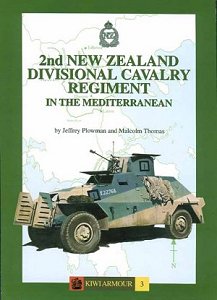

 2nd
New Zealand Divisional Cavalry Regiment in the Mediterranean
2nd
New Zealand Divisional Cavalry Regiment in the Mediterranean Review by Peter Brown
For those studying armour, the Regiment was equipped with a wide range of vehicles. Starting with Carriers on formation which they used throughout, they progressed to British Light Tanks of the Mk II and Mk VI series in North Africa and Greece, alongside South African-built Marmon Herrington armoured cars, taking over Stuarts in late 1942 - including one which had at one time been in German service - before converting to American Staghounds and Canadian Lynxes in Italy. Many of their vehicles were modified, for example they were instrumental in producing the 3" Howitzer conversion for the Staghound and many of their Carriers carried extra armament.
Photos show these vehicles to good advantage, and the use of private photos taken by those who operated them means that the greater part of them have not appeared in print before. There are also two bonuses, with photos of the Stuart command tank used by General Freyberg and another series of Carriers used by their parent 2nd New Zealand Division. Special attention is given to colour schemes and markings, several vehicles are the subject of colour illustrations and the organisation of the unit is shown using silhouettes of the vehicles they had along with full lists of unit serial numbers for the whole Division. Modellers will find this useful enough, but there are also 1:35th scale plans of the Light Tank Mk VIb, Marmon Herrington armoured car and Mk I Universal Carrier and notes on available kits. There are even useful details of uniforms for completeness.
As with the first two books, there is a wealth of information here and all throws new light onto a Regiment which will be mostly new material outside New Zealand and maybe at home as well. For anyone seeking a new area to study or inspiration for models, this will give them plenty to work on.
For details of how to obtain this and the earlier books, see the Kiwis In Armour web site.
Page created 19 May 2002